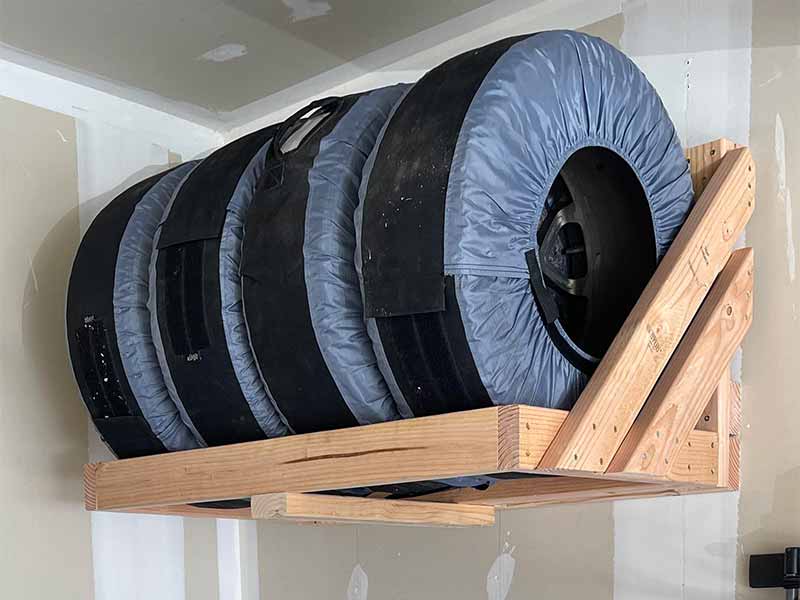Imagine you’re about to embark on a long-awaited road trip or store your cherished vehicle for the winter, only to realize your smooth ride might be compromised by flat spots on the tires. Ensuring your tires are in top condition is crucial for a smooth journey and long-term vehicle maintenance.
How To Prevent Flat Spots On Tires During Storage
The best way to prevent flat spots on tires during storage is to either hang the tires mounted on wheels from wheel hooks and ensure the tires are properly inflated. If still mounted on a car or truck, place the vehicle on jack stands.
Don’t stack tires horizontally if wheel hooks aren’t available. rotate regularly and keep stored at a stable temperature if possible and away from direct sunlight. Using airtight tire storage bags to protect from dry rot is recommended.
In this article, we’ll guide you through understanding what flat spots are, how to prevent them in both parked vehicles and stored tires, and how to address them if they occur. We’ll provide you with straightforward, practical advice and maintenance tips to ensure your tires remain in optimal condition for your safety and driving pleasure.

Jack Stands
Understanding Flat Spots on Tires
Flat spots on tires aren’t just a nuisance; they’re a wake-up call to vehicle owners everywhere. Imagine gearing up for a long-awaited road trip only to find your trusty car riding bumpy and uneven. That’s the reality of untreated flat spots. In this section, let’s decode what causes these pesky tire issues, and how you can spot them before they dampen your drive.
What Causes Flat Spots?
Flat spots are exactly what they sound like — areas on the tire that have become flattened due to constant pressure against a hard surface. They typically occur in two scenarios:
- Prolonged Parking: When your car plays more of a ‘sitting duck’ than ‘speeding gazelle,’ tires can develop flat spots where they contact the ground. It’s a common issue for vehicles parked for extended periods without movement.
- Improper Storage: Tires not on vehicles aren’t immune. When stored improperly, they too can develop these flat areas, leading to uneven wear and potential safety issues down the line.
Symptoms of Tire Flat Spots
Spotting flat spots early can save a lot of headaches (and wallets!). Look out for these signs:
- Vibration and Bumping: One of the first signs is a ride that’s more roller coaster than road trip. If your car shakes or vibrates, especially at certain speeds, it’s time to check your tires.
- Noise: Listen for unusual thumping sounds from your tires. It’s like they’re complaining about the flat spots!
- Visible Flattening: Sometimes, you can see the flat spot on the tire, a definite sign that it’s time for a closer look or a visit to a professional.
For more on spotting these symptoms, delve into our detailed guide on Flat Spots on Tires Symptoms.

Tire Storage Bags
Prevention Strategies for Flat Spots on Tires
Preventing flat spots is all about understanding the enemy and knowing your defense strategy. Whether it’s for a vehicle parked for an extended period or for tires stored away from the vehicle, taking the right precautions can save you from the hassle of dealing with flat spots later. Let’s look at how you can keep your tires round and ready for the road.
For Parked Vehicles
- Proper Inflation: Keep tires inflated to the manufacturer’s recommended pressure. It’s simple but effective. Underinflated tires are more prone to flat spotting, as they can’t maintain their shape as well against the weight of the vehicle.
- Use of Jack Stands: Jack stands will allow the tires to be completely protected from vehicle weight and is ideal.
- Use of Tire Cradles or Supports: Consider using tire cradles or supports, especially for long-term storage. These distribute the weight of the car more evenly and reduce the stress on any one part of the tire.
- Regular Position Changes: If possible, move the vehicle slightly every few weeks to change the tire’s resting position. This small act can make a big difference in preventing flat spots.
For Stored Tires
- Environmental Conditions: Store your tires at a stable and cool temperature, dry place away from direct sunlight and sources of ozone, like electric motors. Heat, temperature cycling, and sunlight can accelerate the deterioration of rubber, making flat spots more likely or worse.
- Heated & Cooled Storage Units: Popular in harsh winter areas, tires are often stored with storage companies that have heated and cooled storage units.
- Hanging from Wheel Hooks: If still mounted on wheels and properly inflated, hang from wheel hooks to eliminate the chance of flat spots.
- Positioning and Rotation: Keep tires vertically and rotate their positions if they’re going to be stored for an extended period. If you need to stack them, try to reposition them occasionally to prevent the bottom tires from deforming.

Wheel Hooks
How to Get Rid of Flat Spots on Tires from Sitting
So, you’ve identified that dreaded flat spot on your tire after a period of sitting idle, or you’ve pulled out a set of stored tires only to discover they’re not as round as they once were. Don’t fret! Let’s walk through the steps you can take to smooth out those bumpy issues and restore your tires’ roundness.
For Parked Vehicles
- Slow and Steady Driving: Initially, drive slowly and avoid high speeds. This allows the tire to warm up gradually, potentially easing out minor flat spots.
- Increase Driving Distance: Sometimes, just a few miles isn’t enough. If safe and practical, consider a longer drive to allow the tires to fully heat up and regain their shape.
- Professional Inspection: If the flat spot is severe or doesn’t improve with driving, it’s time to consult a professional. They can assess whether the tire is salvageable or needs replacing.
For Stored Tires
- Inspection Before Mounting: Before you put stored tires back on your vehicle, give them a good look over. Check for any visible signs of flat spots or other damage.
- Consider a Tire Specialist: If you’re unsure about the condition of the tire, have it inspected by a specialist. They can determine if the flat spots are temporary or if the tire needs to be replaced.
For more detailed guidance and solutions, explore our in-depth article on How to Get Rid of Flat Spots on Tires from Sitting.

Tire Cradles
Permanent Flat Spots on Tires
Discovering a flat spot on your tire is one thing, but understanding when it’s crossed the line into being a permanent issue is another. Permanent flat spots are the point of no return, where the tire’s integrity is compromised, and safety becomes a concern. Let’s delve into what makes a flat spot permanent and what your next steps should be.
Understanding Permanent Flat Spots
Permanent flat spots occur when the tire’s structure is fundamentally altered, and no amount of driving or warming up will return it to its original shape. Here’s what contributes to a flat spot becoming permanent:
- Extended Period of Immobility: The longer a vehicle is stationary or a tire is improperly stored, the more likely the flat spot will become permanent.
- Severe Weight and Pressure: Heavy vehicles or improperly stored tires under weight can cause severe deformation.
- Age and Condition of the Tire: Older tires or those already weakened by wear and tear are more susceptible to permanent flat spots. Tires older than 10 years should be replaced despite their condition due to aging concerns.
Signs of Permanent Flat Spots
- Persistent Vibrations: If the vibrations or thumping sounds don’t resolve after repeated driving, the flat spot might be permanent.
- Visible Deformation: If the flat area is visibly pronounced and doesn’t lessen, it’s likely a permanent issue.
- Professional Confirmation: A tire specialist can confirm if the deformation is beyond repair.

Craftsman Portable Air Compressor
Maintenance Tips for Prolonged Storage
Whether you’re tucking away your vehicle for the off-season or storing a set of spare tires, proper maintenance is key to avoiding flat spots and other tire issues. Here are some essential tips to ensure your tires stay in top condition during extended storage periods, keeping them round and ready for action when you need them.
For Long-term Vehicle Parking
- Ideal Storage Conditions: Store your vehicle on jack stands in a cool, dry place to prevent environmental damage to the tires. If possible, avoid leaving your car on asphalt or any surface that can significantly heat up or transfer cold.
- Use Jack Stands or Tire Cradles: If you’re looking at very long periods of storage, consider using jack stands or tire cradles to relieve pressure off the tires.
- Regular Inflation Checks: Even while in storage, check tire pressure periodically to ensure they remain at the recommended levels. Tires lose 1 to 3 psi each month due to permeation.
- Move the Vehicle Occasionally: If you are unable to use jack stands, slightly move the vehicle once a month to prevent prolonged pressure on one part of the tire.
For Tire Storage
- Clean Before Storing: Remove any dirt or debris from the tires. This prevents any chemicals or materials from sitting on the tire and causing damage over time.
- Store in a Cool, Dry Place: Like with the vehicle, store your tires in an environment that’s away from direct sunlight and significant temperature changes.
- Avoid Stacking: If you’re storing tires vertically, avoid stacking them directly on the tread for long periods, as the weight can cause shape distortion on the bottom most tire.
Regular Maintenance Checks
No matter how long you’re storing your vehicle or tires, regular maintenance is crucial. Here’s what to keep in mind:
- Routine Inspections: Periodically check the tires for any signs of flat spots, cracks, or other damages.
- Professional Advice: If you’re unsure about any aspect of tire storage or maintenance, seek advice from a tire professional. They can provide tailored guidance based on your specific storage conditions and tire types.
Resources
Below are some links you may find helpful when learning about tires:
Final Thoughts
Flat spots on tires can be a real bummer, but with the right knowledge and care, you can prevent or remedy these issues and ensure a smooth drive.
Regular inspections, proper inflation, and appropriate storage are your best bets in maintaining tire integrity. Don’t let a little neglect lead to bumpy rides or, worse, tire replacements.
Keep this guide handy, and refer back to it whenever you’re planning to store your vehicle or just in need of a tire check-up.
Good luck and happy motoring.




